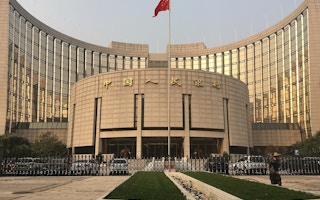In a world beset by crises, one is not getting nearly enough attention: the sovereign-debt emergency faced by half of the world’s emerging and developing economies. Fortunately, a new innovation in sustainable finance has emerged that may help countries to avert debt disaster, while tackling other crucial challenges, especially nature degradation and climate change.
To be sure, there have been valiant efforts to use traditional political and technocratic channels to address the looming wave of sovereign-debt crises. Bodies like the G20 have produced frameworks, instruments, and initiatives aimed at providing a lifeline to debt-distressed countries, and institutions like the World Bank have attempted to convince major creditors, including the new generation of major sovereign creditors such as China, to offer debt relief.
But, with sovereign-debt risk taking a back seat to what are widely viewed as more imminent domestic and regional systemic crises, little meaningful progress has been made.
The consequences of inaction are far-reaching. Fiscally strained governments cannot meet their populations’ fundamental needs, with ever-larger numbers of people confronting food and fuel insecurity.
Beyond the humanitarian dimensions of this situation, the resulting social and political distrust and instability undermines global cooperation on shared challenges, from climate change to conflicts like the Ukraine war.
Against this dire backdrop, sustainability-linked sovereign debt could be a game-changer. The mechanism is simple: sovereign borrowers define performance targets in relevant areas, such as greenhouse-gas emissions and deforestation. If they meet the targets, they are rewarded with lower debt-servicing costs.
For example, last year, Uruguay issued $1.5 billion in sustainability-linked bonds (SLBs), maturing in 2034, and could see its associated debt-servicing costs fall by up to 60 basis points. The project-based “green bonds” of the past, by contrast, delivered an advantage of just a few basis points, at best, while requiring debtors to bear the considerable costs of defining, monitoring, and reporting the “use of proceeds.”
Debt-distressed countries can secure even larger reductions in debt-servicing costs if sustainability-linked performance agreements are backed by public guarantees to lenders. In fact, of the seven pathways for scaling up the sustainability-linked sovereign financing approach presented in a new report from the Sustainability-linked Sovereign Debt Hub (for which I am Convener of the Advisory Board), the one with the highest potential for tackling the current crisis is credit enhancement.
Along this pathway, sovereign credit risk is transferred to guarantors such as multilateral development banks, bilateral development-finance institutions, and private insurers. A credit guarantee, insurance policy, or other credit-enhancement mechanism improves the debt’s rating, thereby reducing the sovereign issuer’s servicing costs and unlocking additional funds.
This in turn expands debtor countries’ fiscal space, unlocking more resources to invest in both meeting performance targets and advancing other priorities.
Already, credit enhancement has facilitated debt-refinancing in Barbados and Belize, with both countries channeling some of the cost savings toward financing coastal restoration.
Best of all, if the combination of greater debt sustainability and improved nature and climate outcomes bolsters resilience and productivity, sovereign risk – and overall debt-servicing costs – will fall further, setting in motion a much-needed virtuous cycle.
Scaling up credit enhancement to support sustainability-linked sovereign financing would require cooperation involving multilateral development banks, the OECD countries, and other major sovereign creditors, such as China. While ambitious in today’s fractured world, such a mechanism would underpin a value-for-money approach to addressing both the debt crisis and broader sustainability challenges.
Other pathways identified in the Sustainability-linked Sovereign Debt Hub report include standardisation of instruments and metrics – crucial to lower the cost of issuance and oversight of performance-based strategies, and to reduce the likelihood of greenwashing. Strengthening institutional capacity is also essential, especially for under-resourced low-income issuers. And efforts must be made to increase market awareness of, and private sector appetite for, sustainability-linked debt.
If these pathways are taken, emerging-market and developing-economy sovereigns could issue $250-400 billion in SLBs by 2030, according to estimates by NatureFinance, up from just $3.5 billion at the end of last year. Under these projections, SLBs could comprise 6-9 per cent of the projected 2030 stock of external public debt owed by emerging and developing economies.
Of course, performance-based sovereign-financing instruments are nothing new, and their track record is far from perfect: debt-distressed countries have often faced contentious forms of macroeconomic, fiscal, and institutional conditionality. And when it comes to debt, development, or sustainability, there has never been a silver bullet.
Nonetheless, by linking debt relief with efforts to address broader challenges like climate change, and enabling debtors to set their own performance targets, SLBs may be able to succeed where traditional political approaches have failed to mitigate short-term sovereign-debt risks and bolster long-term sustainable development. A silent revolution in sovereign financing may already be in the making.
Simon Zadek is Executive Director at NatureFinance.Copyright: Project Syndicate, 2023.www.project-syndicate.org











